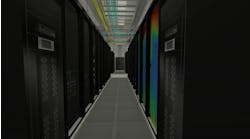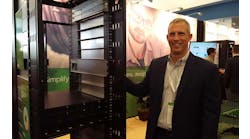Picture this: A supercomputer in a van, using artificial intelligence to create flight paths for drones collecting high-definition images of critical infrastructure. It’s not science fiction, but the business model for Avitas Systems, a startup spawned by GE as part of its Internet of Things business.
Avitas uses drones to provide automated safety inspections of oil and gas facilities. It uses artificial intelligence (AI) to deploy drones and analyze the HD imagery and video they collect. This requires major data-crunching, which is provided by the NVIDIA DGX Station, a desktop-sized supercomputer loaded with NVIDIA graphics processing units (GPUs).
“Storing and processing this large amount of data resources requires a huge amount of computing power,” said Alex Tepper, the founder and Head of Business Development at Avitas Systems. “We’re passionate about pushing AI as far as possible out on the edge.”
The Avitas collaboration with NVIDIA illustrates how new technologies are driving change in the design and location of computing infrastructure. Drones, autonomous vehicles and augmented reality apps rely upon artificial intelligence, which in turn requires high performance computing (HPC) to crunch data. The need for latency and data transfer dictates that much of this new computing infrastructure will be distributed, creating demand for new form factors.
NVIDIA’s graphics processing (GPU) technology has been one of the biggest beneficiaries of the rise of specialized computing, gaining traction with workloads in supercomputing, artificial intelligence (AI) and connected cars. The Avitas project showcases how its DGX “supercomputer in a box” can be deployed in both the data center and the field to support next-generation technology.
Bringing AI to the Edge
Boston-based Avitas uses computer vision techniques to detect faults and create “heat maps” of pipelines and refinery equipment. It uses AI to create flight plans for drones equipped with sensors and cameras to collect data and video footage. That data-crunching is done with an NIVDIA DGX-1 system housed in a traditional data center, which “trains” the Avitas algorithms to recognize objects.
“AI is core to how we do analytics and core to our platform,” said Tepper. “We’re using it to train our algorithms in the data center, and also in the field as well. We operate in very harsh environments.”
Tepper says the sites being inspected are often near the “edge of civilization,” which often means oil rigs or deserts far removed from robust networking infrastructure. The huge flow of data returning from field drones and robots is often too large to be sent back to the data center for deep learning inferencing – in which the AI neural network applies its capabilities to new data, using its training to identify patterns more quickly than humans could.
The NVIDIA DGX Station is a desktop-sized “supercomputer in a box” for AI applications. (Photo: NVIDIA)
Enter the DGX Station, which packs 480 teraflops of computing power into a compact form factor, using an Intel Xeon CPU and thousands of NVIDIA GPU cores. The DGX Station was designed as a desktop workstation, which could bring high performance computing (HPC) out of the data center. It comes pre-loaded with AI frameworks and libraries. The system is about the size of a traditional desktop tower, and weighs 88 pounds.
Avitas began using the DGX Station in the field, allowing it to easily offload large images and datasets from the drones and run advanced analytics to detect any anomalies in the imagery that might suggest a maintenance issues. Tepper said Avitas was able to use DGX Stations in the field without any special modifications.
“We typically have a local base of operations,” said Tepper. “It may be a nicely-tricked out van. Often we will transfer it to a more permanent environment like a data closet. We’re not asking NVIDIA to ruggedize the hardware.”
Jim McHugh, VP and General Manager at NVIDIA, noted that the DGX Station is water-cooled, which allows it to support dense workloads in a wide range of temperature environments.
“Avitas Systems is breaking new ground by bringing NVIDIA DGX Station beyond the deskside and into the field for the first time,” said McHugh. “We want to put it in vans and put it in remote locations in a desert or an oil rig. We’ve shared the prototypes with Avitas and they’re using them.”
Drones Drive Safety, Savings
Avitas Systems uses drones, robotic crawlers, and autonomous underwater vehicles (AUV) to conduct its inspections. It can develop deployment paths, driven by 3D models, that can be repeated from the same angles and locations. The paths’ repeatability means a wide variety of images captured over time can be inputted into Avitas’ cloud-based platform, where advanced image analytics can detect changes and measure exact defects on an industrial asset, such as cracks and corrosion. Avitas can also rate the severity of defects, allowing customers to determine when equipment needs to be replaced.
Most of these inspections are currently done by employees, which often involves climbing towers and other infrastructure. Automating these tasks with drones and robots is safer, and Avitas says it can also lead to improved inspections, as the AI systems can detect flaws that may be less perceptible to the human eye.
“Using our latest DGX systems to help train robots and better predict industrial defects increases worker safety, protects the environment, and leads to substantial cost savings for companies,” said McHugh.
Deploying advanced IT systems in harsh environments is nothing new. Oil and gas companies have used modular enclosures to create on-site data centers for some time. The military also makes extensive use of modular data centers.
The rise of edge computing is creating more opportunities for these types of specialized data center implementations. That includes the development of micro data centers within office buildings by companies like DartPoints – which effectively builds a better IT closet. Companies like DataBank and Vapor IO are partnering with telecom real estate firms to deploy micro data centers at the base of call towers.
NVIDIA believes the rise of AI will take these trends to the next level, driving the need for new products that deliver HPC-style computing power in an even more compact form factor. It’s among a growing number of hardware players fueling a renaissance in chips and servers to infuse intelligence into next-generation services.
The DGX Station is a move to productize this trend, and Avitas is an early look at some of the use cases that may drive demand for these offerings. As our devices get smarter and more powerful, the data center will be extended nearly everywhere.
“We truly believe people are using this for a new form of computing, not just in the data center but out at the edge,” said McHugh.
Explore the evolving world of edge computing further through Data Center Frontier’s special report series and ongoing coverage.






